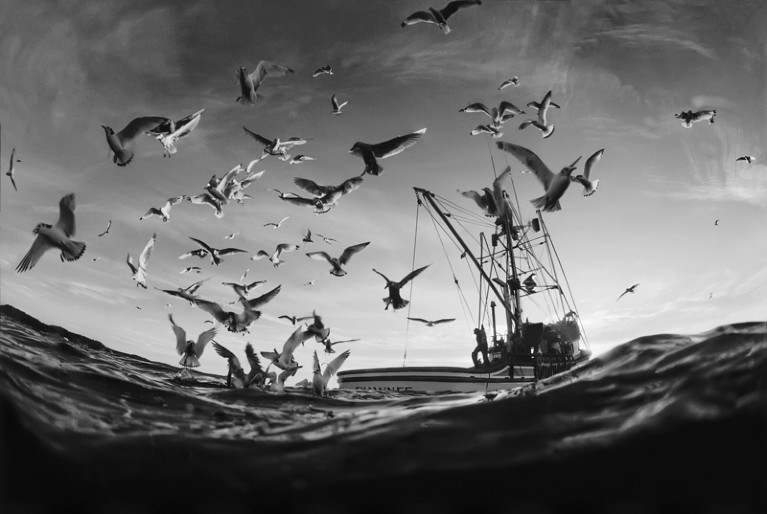
A new global treaty could protect international waters from overfishing.Credit: David Doubilet/Getty
In a rare diplomatic breakthrough — and good news for marine scientists and conservationists around the world — nations agreed in 2016 to protect a huge area of ocean off the coast of Antarctica from commercial fishing and other harmful activities. That success came only after years of failed discussions. It was followed by another positive step: in December, Arctic Council countries decided not to fish industrially in the Arctic Sea.
These are good signs. Still missing, though, is a more significant agreement — a mechanism that would allow governments to create marine reserves in ecologically crucial ocean regions beyond any national jurisdiction.
Could the United Nations Convention on the Law of the Sea fill the gap? The UN thinks so. On 24 December, it convened an intergovernmental conference to produce a legally binding treaty on the conservation and sustainable use of biological diversity in the high seas outside national maritime boundaries. It’s a crucial first step, and is encouraging because it suggests that political will is building to draft international rules that protect the ocean wilderness.
The vote, after almost a decade of preparatory work, reflects scientists’ growing concern about the alarming state of the global oceans. And public awareness about issues such as overfishing, plastic pollution and species extinction is sharply on the rise in many countries.
The planned treaty, due by 2020, is much needed. A global commons, the high seas cover half of Earth’s surface and provide eco-services of immeasurable value. Still, any new pact cannot address all the ills of the seven seas. The surge in plastic waste, for example, has to be tackled at its terrestrial source, mainly with the producers. But a well-crafted and properly enforced rulebook can do much to protect ocean ecosystems from man-made harm.
Any future network of high-seas reserves will need to cover a large variety of species in representative ecosystems in all climate zones. To do this, researchers with the UN Convention on Biological Diversity suggest that marine protected areas should cover at least 10% of the global ocean by 2020. At present, the figure is closer to 6% — almost all in coastal waters. The higher target will be impossible to reach without setting aside reserves in high-seas regions that are as yet legally out of reach. Hence the need for a new treaty.
The treaty’s range and scope are yet to be defined, and science has the chance to help frame its demands, and to ensure that the goals of protection and conservation are effectively met. Our understanding of marine ecosystems is best for coastal and inshore regions. An evidence-based approach to protecting the wilderness of the high seas will require massive amounts of research. For example, to get a better sense of the scale of the looming ocean crisis, scientists need to map ecosystem structures and deep-seabed habitats, and to track migratory patterns of critical species. They will also want to take a closer look at how biological processes in the deep ocean control key chemical cycles, such as carbon uptake and release, that govern Earth’s climate.
Research can benefit from, as well as inform, protection. Recent studies show that marine reserves can help species adapt to ocean acidification and other impacts of climate change (see, for example, C. M. Roberts et al. Proc. Natl Acad. Sci. USA 114, 6167–6175; 2017). Such areas can serve as a control by which to evaluate the impact of fishing and environmental change on marine ecosystems. Researchers can also help to set priorities, by working to identify key ecosystems that need protection from overfishing and other human interference.
A meaningful high-seas pact must also encourage effective fisheries management outside protected areas, to support sustainable catch. And implementation of any rules will have to rely on effective satellite surveillance of fisheries activities on the open ocean. The International Maritime Organization (and Interpol) is already using vessel-monitoring technology to track ship movements and suspicious activity.
The next step will be the first session of the intergovernmental conference, on 4–17 September. It is unclear whether key fishing nations — including the United States, Russia and China — will ratify any agreement. Encouragingly, these countries have not blocked the work of the preparatory committee. Other nations, including Norway, Iceland, Japan and South Korea, have signalled full support for a legally binding instrument. The number of signatures required for the treaty to be enforced is yet to be negotiated.
Whatever arrangements emerge, the UN’s move should provide ample research opportunities. Funders should take note. A treaty involving an international research mandate — including a regime to regulate controversial geoengineering experiments such as ocean iron fertilization — would be a boon for ocean health and responsible science.

 Marine biodiversity needs more than protection
Marine biodiversity needs more than protection
 Marine conservation: How to heal an ocean
Marine conservation: How to heal an ocean
 World’s largest marine reserve hailed as diplomatic breakthrough
World’s largest marine reserve hailed as diplomatic breakthrough


